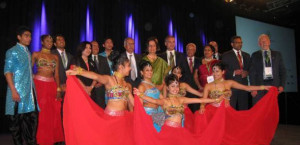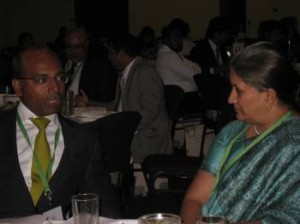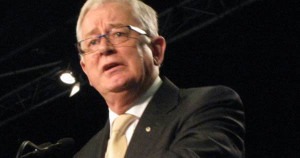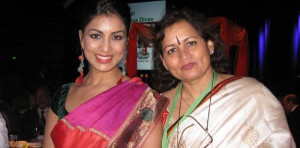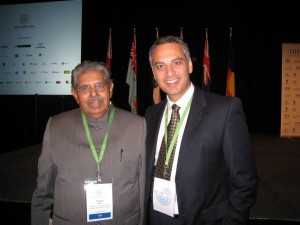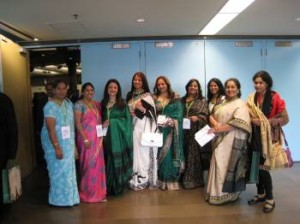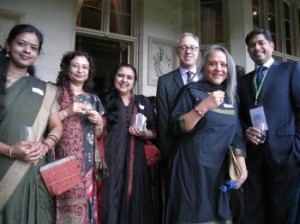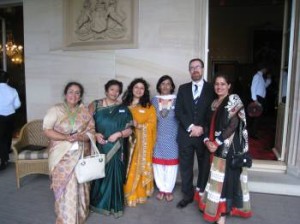Regional Pravasi Bhartiya Divas 2013 Sydney lukewarm on attendance yet a success!
Team PBD with HE High Commissioner of India Mr Biren Nanda
By Neena Badhwar
The last key note played on cricket by the former Australian captain Steve Waugh, the stands in Sydney where the regional Pravasi Bhartiya Divas (PBD) was being played, were rather empty but the test was a successful event.
There were many topics dwelled on, and many relationships formed during the 3-day event at the Convention Centre in Darling Harbour attended by both the government representatives ”“ Australian and Indian, were in full force, as well the business interests.
The delegates were entertained by the likes of Pandit Shivkumar Sharma, vocalist Meena Pandit and Kamahl who enthralled the audience with his Gattisburgh address.
While on the streets of Sydney good 95,000 people of Indian origin walk and many more as students and people on temporary visas, unaware of the goings on at the Sydney city’s Convention & Exhibition Centre, there are about 600 attendees at the Regional Pravasi Bhartiya Divas 2013 who are busy discussing in various sessions by selected experts issues such – how the NRIS can engage with India, bilateral business opportunities , bilateral cooperation opportunities in resources, skills, infrastructure, education, engagement through culture, Indian diaspora in the pacific. Also there are few sessions on ”˜Sharing Experiences’ to do with ”˜success stories’ , scientists, academics and topics such as ”˜power of media in the Asian century’, ”˜India Australia Strategic Partnership’ and ”˜sharing of experiences of doing business with India’. At times these hotly rather intensely discussed sessions are randomly visited by the Honourable Minister, Vayalar Ravi, Minister of Overseas Indian Affairs. Mr Ravi is quiet, sits at the back patiently and just listens in on the discussion moderated by a capable expert in the field.
It is difficult to be present at all the sessions yet one sees delegates running from one auditorium to another to attend topics of particular interest to them. In between grabbing a bite, a drink or a piece of fruit or finding moments to network, make friends, meet new people, exchange business cards, visit stalls displaying useful material and the main auditorium busy presenting cultural performances by bharatnatyam, Bollywood and folk dancers, a sarod player, vocal recital and even an enlightening spiritual talk by Swami Sridharananda ji of Vedanta Centre, Sydney.
Aided by young disciples swami Sridharananda advocates in a very calm and peaceful manner how to relieve oneself from the chaotic way of living life and follow a path of pursuit to man-making character-building attitude to life and live in this world yet not of this world. While contributing to the world yet develop a character of non-attachment and do karma for karma’s sake without the expectation of the fruit of karma. He said, “Swami Ramakrishna found in Vivekananda a disciple who worked to bring this philosophy practiced by the sanyasis resigned to the hills and dales way deep in the jungles back to the normal worldly human beings.” That it is not just something to be pursued by sanyasis but also by the common folk who could also benefit from Vedanta. He said that Swami Vivekananda made the old scriptural philosophies that is Vedanta a life and study to be pursued by every human being so that we could live in a peaceful world, something that the world is in desperate need today.
Sydney, as revealed by a delegate from America, Munish Gupta, who has attended many a PBD conference and a regional one in America, “that the session on language was unique which I have not seen in any PBD conference.” Moderated by Mrs Mala Mehta the panelists talked about languages the threat they are facing and the difficulties in maintaining the languages including Hindi in Australia. How the language learning can help connect to the culture of the parents by the children and how they can help young people in getting jobs and the difficulties faced by the teachers who are involved in teaching languages in Australia. Sessions can be run by allowing freedom to be open ended yet a definite time slot can lead to giving freedom to the presenter of whatever they want to say. They can be more thought-provoking when moderated skilfully so as to bring out real issues to the fore by the panelists. This is what was found missing in this session when the 3-minute bell interrupted the speaker some taking more time than even the allotted 3 minutes. The moderator could have asked thought provoking questions and hence able to elicit thoughtful answers to the issues around languages and the threat they face in this global world. Still it was a well attended and well discussed session which went on beyond its its’ allotted time by good half hour.
Another interesting and a very good session was on the ”˜Power of Media in the Asian century’ ”“ conducted by the chair and moderator Sushi Das, Opinions Editor, The Age. This was quite a good session as Ms Das conducted it well and kept the objective in tow by asking questions and getting expert opinions of the panellists sourced from Television, Film, Radio and print. But the power of media to do with print in the local scene and their contribution was missing or even sharing their experience as such was missing. The panelists did discuss the onslaught of technology and its impact on media, authenticity and verification of stories in reporting. Verification and research is quite difficult to achieve according to a journalist from Melbourne, Neeraj Nanda. Mr Nanda said that in the world of churning out news in ’24/7’ it was difficult to find time to verify the stories. Moreover they are developing stories which evolve as they go, he said.
Piracy issues, copy paste journalism, Facebook and Twitter journalism was all discussed and how the technology had transformed the way the news was being fed to the people. Saba Abdi, Kumud Merani, Ana Tiwary, Kartik Mohandas, Neena Bhandari, Munish Gupta, Anupam Sharma , Manpreet Singh made an enlightening panel and discussion on the power of media during the current times as they sounded pretty optimistic about media and its power even when they felt threatened by it all.
Honouring success stories was another session which was quite good. Moderated by the chair Neville Roach we had the opportunity to hear two success stories. One from Mr Maha Sinnathamby who is building the largest city in Queensland, in fact the largest in the world, having acquired thousands of hectares of land and said that he has the backing of 5 premiers and two Prime Ministers as he bragged that ”˜government loves me’. Maha’s advice was that we should not label ourselves as Indian because by so doing we are already lowering ourselves and the opportunities that lie in front of us. He gave the example of Gandhiji that things that great man left behind would not be worth even $2 yet he had left a legacy of a great message of ”˜non violence’ and ”˜peaceful resistance’ to the world.
Another great success story was related to the audience by Mr Brian Hayes, QC, Advisor to the South Australia’s Premier. He said he owed his success to his parents, his Goan mother who worked as a secretary to put him through a good school and stressed the importance of education like most of the Indian families do. “Although I did not face racism because of the elite profession I was in, yet my children at times, one darker than the other due to mixed skin colour ask me ”˜who am I?” said Brian in a moment of reflection and sharing his experience of being in Australia, “Opportunities presented to me in life would not have been if my roots were not from India and my early childhood of 11 years that I spent there.”
Engagement through culture had session chair Aishverya Nidhi with keynote speaker Mr Anthony Steel, Director of Cultural Activities in Australia, who has acted as festival director of six art festivals across the world including Womeadelaide as he paid glowing tribute to living legend Mr Mohinder Dhillon who sat in the audience listening to his friend and supporter Anthony ”˜How Mohindar opened up a whole new cultural treasure of India to Australia and Australians by helping bring every year classical artists of note including the great Amjad Ali Khan, Ustad Ali Akbar Khan, Pandit Shiv Kumar Sharma, Zakir Hussein, U Srinivas, Pandit N Ramani and many more. In fact Sydney PBD was graced by Pandit Shiv Kumar Sharma and his 45 minute Santoor performance all organised by Mohindar Dhillon of Natraj Cultural Centre, based in Melbourne and how that the Centre has been run by putting his own personal funds by Mohindar, said Mr Steel ”“ a true tribute to a friend indeed.
Mr Jeyakumar Janakraj, CEO, Adani Mining with a guest at Gala dinner
”˜Bilateral business opportunities in Resources’ session was devoted to in its keynote address by Mr Jeyakumar Janakraj, CEO, Adani Mining, Brisbane amongst other experts in the resources sector who have bought coalmines in queensland. Mr Jeyakumar shared his company’s profile, its agenda, its objective and the economics of it all including issues and problems they are facing in setting up the project at Carmichael Point, QLD. That they have created their own rail track to cart coal to Abbott Point and finally to Port Mundra to put on on the ships to take it to India and deliver it to Haryana and Punjab. The logistics are mind boggling as Adani Group employs 10,400 employees in Australia to work on the project.
Mr Jeyakumar said, “The GDP of India is directly related to Energy growth and demand and that power plants in India are starving for coal and India needs Australia’s coal for its increasing energy and fuel consumption.”
Mr Jeyakumar talked in trillions showing various graphs and figures to support his presentation. Unbelievable. By the way the dinners served at the PBD were the courtesy of Adani Mining.
Federal Minister for Trade Hon. Andrew Robb during lunch on Day 2 of the PBD Sydney addressed the guests as he mentioned how Indians were a powerful force in globalisation giving the example of Silicon Valley. He said that expertise of the Indian diaspora in Australia-India bilateral relations would help in globalisation and prosperity and peace with increased integration. He iterated that migration was a powerful force in globalisation and that 10 billion AUD worth of flow from India last year was only just a recent phenomenon of which Australia has got to take advantage of.
He said, ‘Australia was unashamedly interested in globalisation and the economic benefits it brings through permanent and skilled migration and quipped that ”˜Australia needs to import few Indian cricketers urgently’.
Mr Robb appreciated the Indian diaspora who value hard work, family besides cricket and that Australia and India were very similar in values. That the Indian community was fastest growing community with second largest intake of students, Punjabi language grew by 200 per cent and Hindu religion was the fastest growing religion here. “We share security and terrorism issues and should maximise our common good with people to people link by broadening the base of our relationship and help strengthen it further.”
“We need to have Free trade Agreements with India as we are doing with Korea, Japan, Indonesia, China and soon we want to reintroduce Colombo plan for study and scholarship thus helping to make a vital link with the Indians here,” said Mr Robb to a resounding applause.
Most of the keynote addresses centred on similar thoughts and actions as Mr Robb with keynote address by Sh Vayalar Ravi, Minister for Overseas Indian Affairs, who said, “India seeks to enlarge its political, economic and security space in our relationship with other countries. There has been a significant expansion of trade and investment between India and Australia. The comprehensive Economic Cooperation Agreement negotiations which we have embarked upon will strengthen institutional connectivity and accelerate the rapid expansion of our commercial ties. Australian companies need to focus their attention on specific sectors in the Indian economy as the government plans to double infrastructure investment to 1 trillion US$ over the next 5 years. The goal is to for annual infrastructure expenditure to reach 10 % of GDP by 2017.”
And to the local Indian community Vayalar said, “Whether you wish to share your knowledge, technology and skills, whether your enterprise takes you to the cities or your compassion brings you to a remote village, I assure you of our continuing effort to support your endeavours.”
He further said, “I am also sure that the MOU on Cooperation in Student Mobility and Welfare between India and Australia will contribute positively to the welfare of Indian students in Australia.”
Another MOU was signed between Overseas Indian Facilitation Centre (OIFC) and Australia India Business Council to foster understanding between Australians and Indians.
All in all Sydney is lucky to have hosted the Regional PBD Conference thanks to the Indian High Commission in Canberra and the Indian consulate in Sydney who chose Sydney as the lucky city out of whole of Australia. 1000 delegates from of various expertise were targeted while hardly 600 registered including in the number were panelists who were the invitees at the event yet one can say that PBD was close to 60 per cent of the success expected as three Australian state premiers, two federal ministers from Australia, two Indian state ministers and Sh. Vayalar Ravi’s quiet presence made up the success and the discussions that happened at various plenary sessions. One panelist put it in succinct manner that issues that are huge to be discussed over three day conference she only got ”˜three minutes to speak’. Even to gather such experts in the field of business, infrastructure, technology, resources, education, media, cultural and some successful stories from NRIs from the Austral-Asia region the conference did succeed in becoming the sounding board for all of us who attended the conference that we all should strive and work towards engaging and strengthening relationship the ties between India and Australia. PBD Sydney was also graced by the presence of state ministers Mr Suresh Shetty, Minister of Protocol and Health, Maharashtra and Mr K. C. Joseph, Minister for Rural Development, Planning and Culture, Kerala.
The criticism being that general NRIS went about their daily lives without knowing that a Regional PBD had ever happened. People who were pulled in in the committees from local Indian community did not and were not able to carry or sell the conference to general public or perhaps the PBD did not use local media effectively to its benefit. Or is it because Sydney had just spent a huge amount of money on Shahrukh Khan show with 11,500 seats sold while PBD could not even pull in enough numbers to make an audience of a 1000 people for a 3-day event with classical concerts, three lunches and two gala dinners and a Bollywood star in Pallavi Sharda of ”˜Besharam movie with Ranbir Kapoor’ also present and the Bollywood extravaganza by the dancers of Shiamak Davar Dance School.
Or is it that the general Indian migrant is too busy eking out a living that helping ”˜strengthen relationship’ between India and Australia as NRIs is the least on their minds.
Pallavi Sharda with mum Hema
If there was some interaction with the grass root NRIs perhaps the topics of discussion would be much different and their demands of a different set of issues as migrants from Sh. Vayalar Ravi whose portfolio is Minister for Overseas Indian Affairs and not just trade.
Sh Vayalar Ravi with Dipen Rughani, National Chairman AIBC
Beautiful people in classical silk saris dressed for the occasion of PBD
Lowy Institute’ Rory Medcalf, Director International Security Programme at the Government house with guests
In final essence the conference was that all who attended ended up playing notes in unison by the end . If the shared dialogue brings about a change and helps create a better understanding and relationship between the two countries it is yet to be seen, in future that is.
Short URL: https://indiandownunder.com.au/?p=2712

